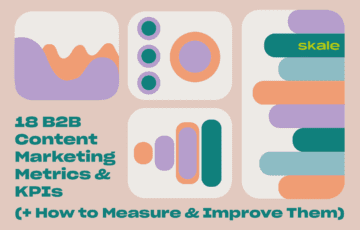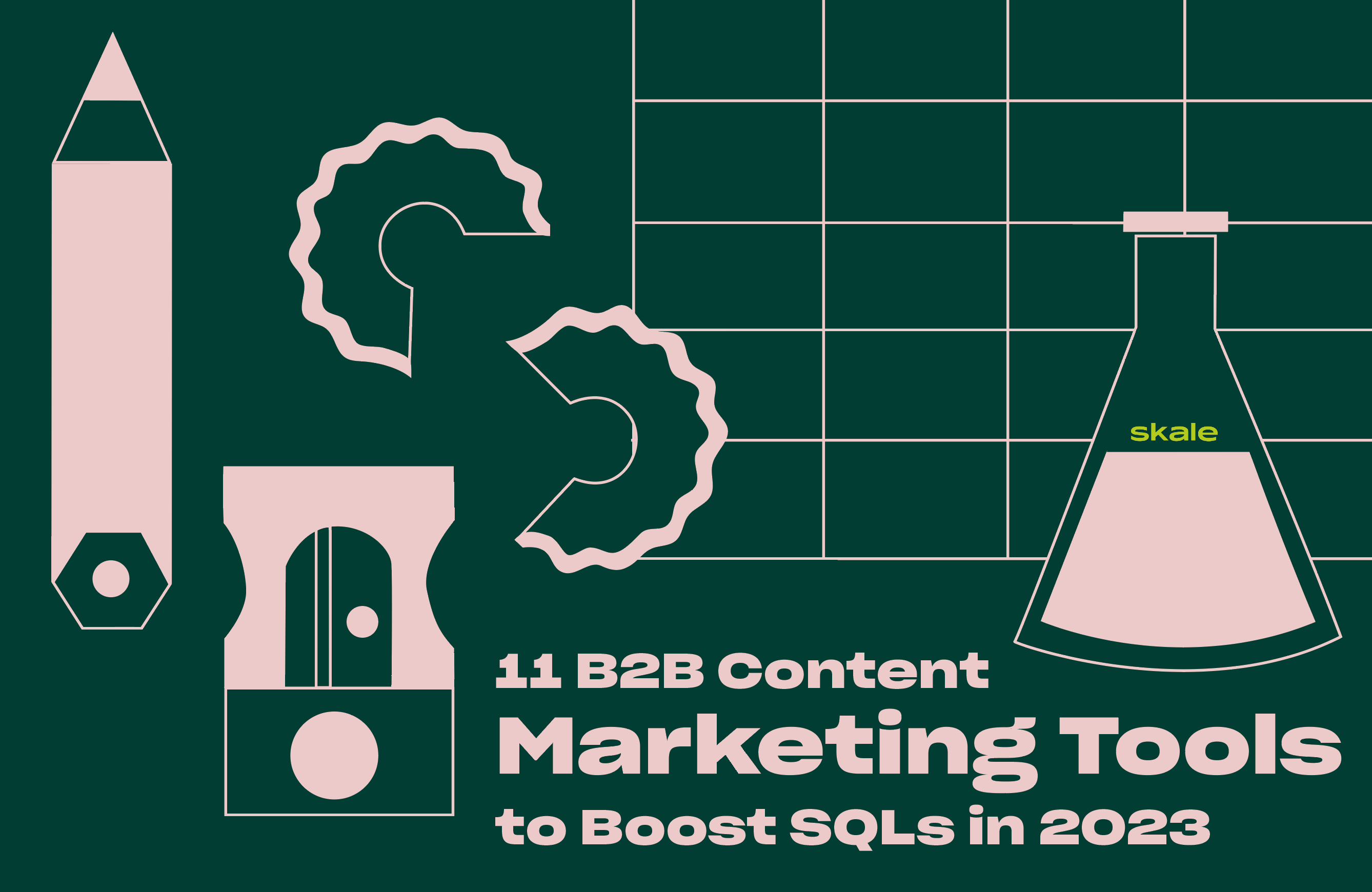
13 B2B Content Marketing Agencies and Services to Generate Revenue in 2024
These B2B content marketing agencies can create strategies and content that generates serious revenue for your business.
![Ignite Engagement: 9 B2B Content Marketing Ideas [with Expert Insights]](png/skale-december-4.png)
Seeing inspiring content from your favorite B2C brand and wondering why you’re not pulling off similar experiences for your B2B business?
B2B seems to be stuck in a content rut. But, at the end of the day we’re still talking to the same audience: humans. No fancy title, company name, or years of experience changes the problems and emotions we encounter every day as humans.
Now, we all know creating helpful content is key to reaching and engaging in-market buyers with information, inspiration, and knowledge. 60% of prospective customers seek out products only after reading related content.
As a B2B marketer, your challenge isn’t just creating content but coming up with B2B content marketing ideas that go above dry statistics, boring content, and corporate jargon. So how do you produce content for every stage of the B2B sales cycle, that gives that same emotion-striking experience that you’ve come to love from your B2C brands?
Here are nine B2B content marketing ideas to ramp up your content-led revenue engine:
With those overviews on the table, let’s get into the ins and outs of each marketing idea.
Smaller content teams often lack the bandwidth to create new content, and that’s where content optimization and repurposing can be your best friend. Putting a fresh coat of paint on your existing content saves your team time while helping you double-down on revenue-generating content pieces already live.
“It should be a top priority of B2B brands to focus on their wealth of existing content before pouring resources into new content. Repurposing and optimising existing content is one of the least resource-intensive yet effective ways to get quick and impactful results.” – Leah Alves, Content SEO Lead at Skale
Content optimization works well because search engine crawlers continuously scan the web to deliver authoritative, helpful, and relevant content to users. A study by Semrush shows that 53% of marketers updating old content experience higher engagement rates, whereas 49% observe an increase in traffic or ranking.
Also, consider content repurposing to convert:
Not sure where to start? At Skale, we create content briefs based on competitor research and expert inputs before updating high-ROI content, meaning every optimization comes with a strategy behind it—not just a date change! We also monitor the metrics after making changes so you know if our changes are on the right track.
Here are some of the things that Leah and the team at Skale focus on when optimizing:
It’s best to start this process off with our B2B content marketing audit guide to help spot and update best-performing topics or evergreen articles. Let’s supercharge your search engine optimization efforts together.
B2B buyers today don’t want a sales pitch. A study by ignite80 and Front shows that buyers prefer intelligent connections and insightful collaboration over anything else. Creating two-way, non-intrusive conversations with interactive content is a great way to give them what they want.
Interactive content is dynamic. Examples include calculators, pop quizzes, interactive webinars, image sliders, and animated videos. Dwelling, a US-based company that helps people buy their first home in Texas, has found interactive content works so well for them they use a calculator on their homepage.

What makes interactive content different is its ability to encourage readers to click, hover, answer questions, all while engaging one-on-one with your brand. Done right, B2B interactive content offers buyers a glimpse of your product without spending money, making them more confident in you.
According to a study by the Content Marketing Institute, 75% of people think that non-gated interactive content provides a sample of a brand, which in turn improves lead nurturing.
Gone are the days when you could visualize the B2B content marketing funnel as a linear, top-to-bottom journey. Today, potential customers go through multiple touchpoints to evaluate a brand’s credibility among peers and fellow users. That’s where user-generated (UGC) content comes in.
Look to gather consumer-generated content on social media channels, Q&A forums, or business software review sites like G2 to share their product experience. Then, you can put the user testimonial in various content formats, like listicles. Attest does this really well, and here’s how you can do it too.

A survey of over 2,000 consumers across the USA, UK, and Australia shows that buyers trust UGC 8.7 times more than influencer content and 6.6 times more than branded content. Moreover, UGC signals experience, expertise, authoritativeness, and trustworthiness (EEAT) to search engines and improve your reputation—so if you can thread this content into your own web content then you’re on to a winning recipe.
A shorter buyer attention span has been a problem for marketers across industries. Yet, consumers worldwide spend 19 hours on average watching online video content. Do you see the opportunity? We do. In fact, 93% of companies acquired new customers using social media video. You don’t want to miss out on video content’s potential.
Short and long-form videos present a unique opportunity for B2B brands to capture buyers’ attention throughout the funnel and leave them asking for more.
Including video in your content marketing strategy lets you:
For example, Leapsome, the intelligent People Enablement platform, peppers their LinkedIn page with engaging video shorts that help build trust, authority, and employer branding.
If you aren’t using podcasts in your current content marketing mix, what are you doing!? 44% Of C-suite executives listen to podcasts to access business-related content. Moreover, branded podcasts increase purchase intent by 14% and brand consideration by 57%.
Podcasts work well because relevant conversations make it easy to pair information with emotion and gain new learning experiences from industry thought leaders. Besides the ease of entry, podcasts let you reach new audiences, build trust, encourage word-of-mouth marketing, and organically showcase your product.
The best thing about podcast marketing is that you build a listener base that keeps returning for valuable insights. Moreover, you can create individual pages for each episode, add meta descriptions, relevant content, and optimize them for specific keywords. The result? Improved visibility on search engine results and more citations from other sites over time.
UserTesting does this strategy very well, and each Podcast page is optimized for SEO too.

Getting visitors to your website is only half the battle, and it doesn’t count unless they become paying customers. That’s why you need lead magnets like ebooks, downloadables, white papers, free trial subscriptions, or interactive demos — anything that lets you collect prospect names and email addresses for future nurturing.
Take a look at Attest, who follows a gated content strategy very well.

As a marketer, you know buyers — and all of us! — want to avoid irrelevant and spammy emails, which is one reason they avoid sharing email addresses. But here’s what you can do to combat this:
Attest goes on to keep the sign up form as simple and clean as possible.

When done right, lead magnets can attract the right leads, show value to potential customers, and grow business sales.
Infographics are a no-brainer for simplifying complex ideas and showing data visually. They’re great for raising brand awareness, improving content shareability, or improving existing content. You can also use them in email marketing content to educate subscribers.
Debbie Moran, Marketing Manager at RecurPost, says, “When analyzing data, I noticed visual content consistently outperforms text-based posts. We launched an array of eye-catching infographics showcasing the benefits of Recurpost on our blogs. The engagement metrics surged, indicating a successful optimization strategy aligned with our audience’s preferences.”
Take a look at the Recurpost blog, you’ll find all of their visuals are annotated, making them more engaging and useful for the reader.

Debbie is right. The best part of creating engaging visuals is that they engage visual learners and make it easier for them to find information. Infographics have a 30x higher chance of being read than an article. Plus, websites that include infographics get 12% more traffic.
If you’re looking to win the battle of attention with infographics that convey new concepts or reveal mind-boggling data, here’s how to start:
Webinars are a game-changer in content marketing because they boost brand recognition, connect companies with target audiences, and drive sales. 73% of marketers believe in webinars’ ability to generate quality leads that convert at an average rate of 46%.
Webinars are effective in B2B content marketing because they let you:
Emilija Kovačević, Marketing Lead at Skale, says, “Webinars usually bring 50 to 150 registrants and only 30-40% people actually attend. Consider creating titles with hooks and actionable phrases to get more sign-ups. Also, it’s worth noticing that webinars with examples and visionary speakers tend to have a higher conversion rate.”
At Skale, we help SaaS brands leverage SEO for maximum visibility– here’s an example of us using a webinar to help our target audience understand the importance of quality content.
66% of marketers consider B2B thought leadership content a top organizational priority. In contrast, only 26% believe their current program will succeed. You get it — every brand wants to be a thought leader in their industry, but how can they pull it off?
Publishing thought leadership content or case studies like we do at Skale means delivering authentic, research-driven, and insightful content that provides educational value and inspires your target audience. When done right, these content formats help you establish brand credibility, attract clients, and generate backlinks from reputed websites.
Start by generating content ideas based on the experiences, opinions, and insights of thought leaders in your organization. Also, consider collaborating with partners, customers, subject matter experts, and opinion leaders to create content that matters to your readers.
Sometimes, marketers can’t afford to build on new content marketing ideas. If that’s you, here are some tactics you can use with your existing content library.
Many businesses ignore zero-volume keywords, thinking no one is searching them. However, these hyper-focused long-tail queries often have less competition, meaning you can quickly rank for them and bring high-intent traffic to your website.
Here’s how you can find these keywords:
Ultimately, the goal is to find and produce content for zero-volume keywords that the ready-to-buy target audience will likely search for. Adding these topics to your content marketing strategy can bring you the most bang for your buck.
Can you remember the best thing that happened to you today? Probably not. You remember the worst thing that happened, right?
Humans tend to register negative stimuli more than positive experiences, and customers aren’t any different. That’s why talking about their pain points is essential to move them closer to a purchase decision. For example, can you create content that highlights what the user’s world would look like without solutions like your product?
You can also analyze customer feedback and talk with the sales team to understand potential customers’ key pain points. Now, show them what happens when pain points go unanswered and challenges pop up without a solution.
You can also adopt a vertical content strategy to ramp up revenue from an already profitable audience. Start by diving deep into B2B content marketing metrics like traffic and conversions to understand what type of content brings the highest ROI for a vertical. Now, perform keyword research to find content ideas and create content that resonates with this specific audience segment.
Imagine running a CRM platform that generates most of its content-generated ROI from blogs about CRM for real estate. Realtors using CRMs are one of your key target audience segments. Consider researching their pain points, finding relevant keywords, and creating content to increase revenue from this audience segment.
No marketers want poor-fit leads because they waste time, and the result is almost always a dead-end sales funnel. That’s why it’s essential to research and define your ideal customer persona based on customers’ budgets, maturity, geography, pain points, and industry.
Understanding your customers’ needs, blockers, and motivations enables you to create unique content that doesn’t just force fit your product’s benefits but also shows how your product can change the user’s life.
Also, consider using ICP to create tailored content campaigns along different phases of user journeys. For instance, if someone needs a quick fix for their problem, can you make content that skips the basics and gives them the solution? When you do that, you minimize customer frustrations and increase customer lifetime value.
Innovation is crucial for creating content that makes a difference. That’s why you need to go beyond the basics to engage with business customers and keep them returning for more. Consider using data-rich research and subject matter expertise to create your company’s interactive content, lead magnets, podcasts, infographics, webinars, and thought leadership content. Done right, this approach will take you beyond ranking- it will generate demand and drive SQLs.
Struggling to improve the number of sales-qualified leads you get every month? Check out these B2B content marketing tools essential to delivering jaw-dropping results. If you need some helping hands, don’t hesitate to give us a shout- we launched a content creation service to help you out.
Learn more about
B2B CONTENT MARKETING

13 B2B Content Marketing Agencies and Services to Generate Revenue in 2024
These B2B content marketing agencies can create strategies and content that generates serious revenue for your business.

18 B2B Content Marketing Metrics & KPIs (+ How to Measure & Improve Them)
We look at which B2B content marketing metrics you should measure, how to measure them, and what to do when you need to improve your content strategy.

11 B2B Content Marketing Tools to Boost SQLs in 2024
We’ve listed top tools to help you research, conceptualize, create & publish content to support your business. Support your business with user-centric content.